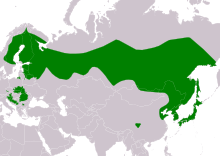| Ural owl | |
|---|---|

| |
| Scientific classification | |
| Domain: | Eukaryota |
| Kingdom: | Animalia |
| Phylum: | Chordata |
| Class: | Aves |
| Order: | Strigiformes |
| Family: | Strigidae |
| Genus: | Strix |
| Species: | S. uralensis
|
| Binomial name | |
| Strix uralensis Pallas, 1771
| |

| |
| Range of S. uralensis Resident
| |
The Ural owl (Strix uralensis) is a large nocturnal owl. It is a member of the true owl family, Strigidae. The Ural owl is a member of the genus Strix, that is also the origin of the family's name under Linnaean taxonomy.[3] Both its common name and scientific name refer to the Ural Mountains of Russia where the type specimen was collected. However, this species has an extremely broad distribution that extends as far west as much of Scandinavia, montane eastern Europe, and, sporadically, central Europe, thence sweeping across the Palearctic broadly through Russia to as far east as Sakhalin and throughout Japan.[1][4] The Ural owl may include up to 15 subspecies, but most likely the number may be slightly fewer if accounting for clinal variations.[5]
This forest owl is typical associated with the vast taiga forest in Eurosiberia, although it ranges to other forest types, including mixed forests and temperate deciduous forest.[5][6] The Ural owl is something of a dietary generalist like many members of the Strix genus, but it is usually locally reliant on small mammals, especially small rodents such as voles.[4][7] In terms of its reproductive habits, Ural owls tend to vigorously protect a set territory on which they have historically nested on a variety of natural nest sites, including tree cavities and stumps and nests originally built by other birds but now, in many parts of the range are adapted to nest boxes made by biologists and conservationists.[8][9] Breeding success is often strongly correlated with prey populations.[10] The Ural owl is considered to be a stable bird species overall, with a conservation status per the IUCN as a least concern species.[1] Despite some local decreases and extinctions, the Ural owl has been aided in central Europe by reintroductions.[11]
- ^ a b c BirdLife International (2016). "Strix uralensis". IUCN Red List of Threatened Species. 2016: e.T22689108A93218506. doi:10.2305/IUCN.UK.2016-3.RLTS.T22689108A93218506.en. Retrieved 12 November 2021.
- ^ "Appendices | CITES". cites.org. Retrieved 2022-01-14.
- ^ Sclater, P. L. (1879). Remarks on the Nomenclature of the British Owls, and on the Arrangement of the Order Striges. Ibis, 21(3), 346-352.
- ^ a b Voous, K.H. (1988). Owls of the Northern Hemisphere. The MIT Press, ISBN 0262220350.
- ^ a b König, Claus; Weick, Friedhelm (2008). Owls of the World (2nd ed.). London: Christopher Helm. ISBN 9781408108840.
- ^ Tutiš, V., Radović, D., Ćiković, D., Barišić, S., & Kralj, J. (2009). Distribution, density and habitat relationships of the Ural owl Strix uralensis macroura in Croatia. Ardea, 97(4), 563-571.
- ^ Obuch, J., Danko, Š., Mihók, J., Karaska, D., & Šimák, L. (2014). Diet of the Ural owl (Strix uralensis) in Slovakia. Slovak Raptor Journal, 7, 59-71.
- ^ Hume, R. (1991). Owls of the world. Running Press, Philadelphia.
- ^ Vazhov S.V., Bakhtin R.F. & Vazhov V.M. (2016). On the Use of Nest Boxes for Study the Ecology of Strix uralensis. International Journal of Applied and Basic Research, 333: 498-498
- ^ Brommer, J. E., Pietiäinen, H., & Kolunen, H. (2002). Reproduction and survival in a variable environment: Ural owls (Strix uralensis) and the three-year vole cycle. The Auk, 119(2), 544-550.
- ^ Scherzinger, W. (2006). Die Wiederbegründung des Habichtskauz-Vorkommens Strix uralensis im Böhmerwald. Zeitschrift bayerischer und baden-württembergischer Ornithologen, 45(2/3).
